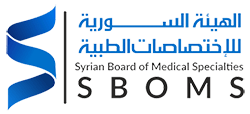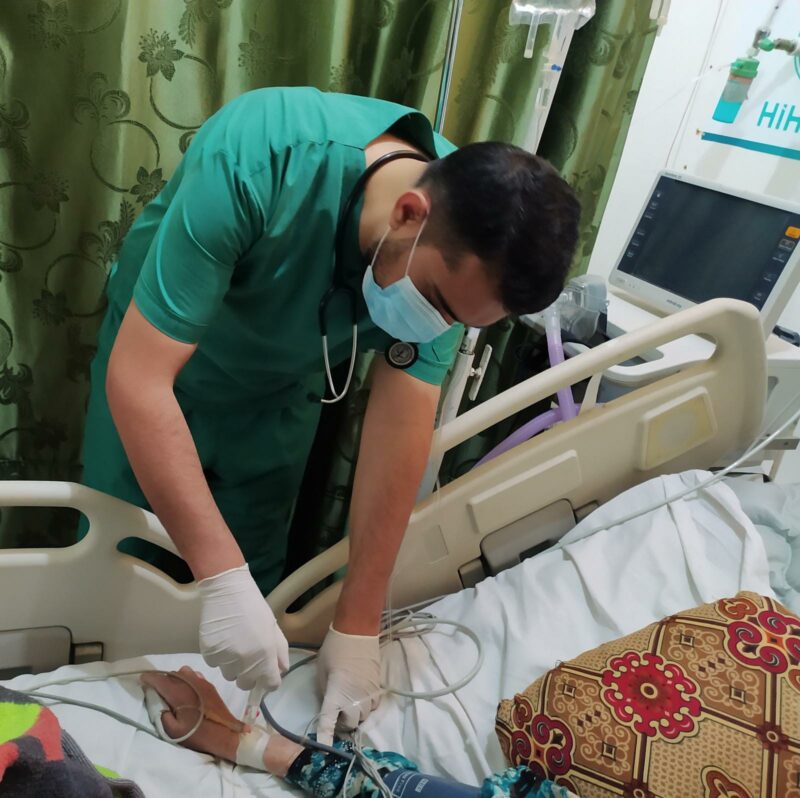Anaphylactic Shock Management
Case history:
Patient R. J, age 64 years old, was brought ER at Armanz Hospital supported by HIH, with a story of general weakness with generalized itching, erythematous rash, urticaria, and vomiting once, after being bitten by an insect a quarter of an hour. The family mentioned a history of chronic stress from 20 years ago with an ischemic heart attack two years ago. Dr. Abdulhadi Alabous Internal Medicine resident under the supervision of Dr. Muhamad Al Halak, manages the case as follows:
Clinical examination: Clinical examination showed:
The patient was conscious and responsive; the airway was opened with spontaneous respiration. The pulse was palpable in the carotid artery but absent and imperceptible in the radial artery.
- The systolic blood pressure is 50 mmHg, and the diastolic pressure is not measured.
- Pulse 110/min, oxygenation 86%.
- The heart S1 S2 was regular with tachycardia.
- The chest was clear and symmetrical.
The initial management:
A large venous catheter was opened at the elbow and oxygen was administered through the mask, followed by administering 0.3 mg of adrenaline in the quadriceps muscle.
With caution, rehydration with systemic saline serum and monitor chest auscultation since the patient has heart disease. Then 500 mg of hydrocortisone was administered intravenously, with an ampoule of 10 mg of Loratadine.
The patient was transferred to the intensive care unit. In the ICU, the patient had dyspnea with wheezing due to spasms of the airways. So, Salbutamol nebulization was added at a dose of 2.5 mg.
Follow-up:
Follow-up of the patient in care: the patient became conscious, responsive, and her general condition became good, and her vital signs were as follows:
- Blood pressure 110/60 mmHg
- Pulse 85/min
- Oxygenation 99%
- Diuresis 50 ml / hour
The patient was discharged after a 24-hour observation with stable vital signs.

Information about anaphylactic shock
Definition:
Anaphylaxis by definition is a serious allergic reaction or hypersensitivity reaction that is usually rapid in onset and potentially fatal and is an acute, potentially life-threatening reaction that results from the sudden release of mast cell mediators. It most commonly results from IgE interactions with foods, drugs, or insect bites, but any agent or mediator which is capable of inducing sudden systemic lysis of the mast cells can catalyze this reaction.
Etiology:
Food is the most common cause in children, and the most common causes in adults are medications and insect stings.
Symptoms and signs:
- Symptoms and signs of the skin and mucous membranes: occur in approximately 90% of attacks and include urticaria, itching or redness, swelling of the lips, tongue, and uvula, periorbital edema, or swelling of the conjunctiva. The urticaria, redness, and itching may disappear when the patient arrives at the medical facility, so it is important to ask about skin symptoms from the beginning of the story.
- Respiratory symptoms and signs: occurring in approximately 85% of episodes, include nasal discharge, nasal congestion, sneezing, itchy throat and ear, hoarseness, a feeling of throat closing or choking, stridor, shortness of breath, wheezing, or coughing.
- Gastrointestinal signs and symptoms: occurring in approximately 45% of episodes, include nausea, vomiting, diarrhea, and crampy abdominal pain
- Cardiovascular signs and symptoms occur in approximately 45% of episodes, including low blood pressure, dizziness, and irregular heartbeat.
Note: Cardiovascular disease is an important risk factor for death from anaphylaxis in middle-aged and older individuals.
Emergency management of anaphylactic shock:
- Management begins with Airway, Breathing, and Circulatory examination, followed by venous catheterization and early intubation if angioedema is suspected or respiratory distress.
- Limit further exposure to the allergen (i.e., stop giving the drug or remove the insect needle).
- First-line treatment of adrenaline in the quadriceps muscle at a dose of 0.3-0.5 mg 1/1000 solution and the dose can be repeated every five minutes as needed.
- In case of hypotension, 1-2 liters of normal saline should be administered.
- In patients who are treated with beta-blockers and have hypotension resistant to adrenaline and fluids, use glucagon 1 g intravenously every five minutes. An infusion of 5-15 mcg/min should be initiated as soon as pressure improves.
- In severe cases, prednisolone 125 mg IV or 500 mg IV hydrocortisone is given.
- Antihistamines in severe cases such as diphenhydramine 50 mg
- Bronchospasm is treated by nebulization such as Ventolin 2.5 mg, in case resistant to treatment add ipratropium bromide spray 250 mcg and magnesium intravenous infusion 2 g over 20 minutes.

